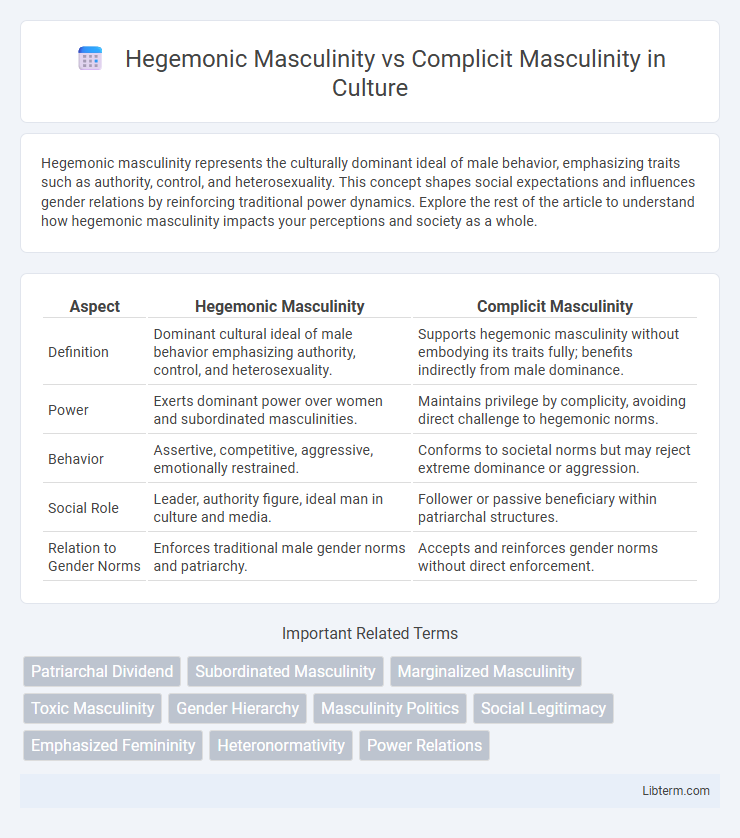Hegemonic masculinity represents the culturally dominant ideal of male behavior, emphasizing traits such as authority, control, and heterosexuality. This concept shapes social expectations and influences gender relations by reinforcing traditional power dynamics. Explore the rest of the article to understand how hegemonic masculinity impacts your perceptions and society as a whole.
Table of Comparison
| Aspect | Hegemonic Masculinity | Complicit Masculinity |
|---|---|---|
| Definition | Dominant cultural ideal of male behavior emphasizing authority, control, and heterosexuality. | Supports hegemonic masculinity without embodying its traits fully; benefits indirectly from male dominance. |
| Power | Exerts dominant power over women and subordinated masculinities. | Maintains privilege by complicity, avoiding direct challenge to hegemonic norms. |
| Behavior | Assertive, competitive, aggressive, emotionally restrained. | Conforms to societal norms but may reject extreme dominance or aggression. |
| Social Role | Leader, authority figure, ideal man in culture and media. | Follower or passive beneficiary within patriarchal structures. |
| Relation to Gender Norms | Enforces traditional male gender norms and patriarchy. | Accepts and reinforces gender norms without direct enforcement. |
Understanding Masculinity: Core Concepts
Hegemonic masculinity represents the culturally dominant ideal of manhood characterized by traits like authority, competitiveness, and emotional restraint, reinforcing gender hierarchies. Complicit masculinity involves men who do not embody hegemonic traits fully but benefit from the existing patriarchal structure without challenging it. Understanding these core concepts clarifies how different masculine identities perpetuate or resist power dynamics in society.
Defining Hegemonic Masculinity
Hegemonic masculinity defines the culturally exalted form of masculinity that upholds male dominance and legitimizes gender hierarchies through traits such as authority, aggression, and heterosexuality. It represents the idealized standard against which other masculinities, including complicit masculinity, are measured but not necessarily enacted fully. This form of masculinity enforces power relations by marginalizing alternative masculinities and subordinating femininities within societal structures.
Characteristics of Hegemonic Masculinity
Hegemonic masculinity is characterized by attributes such as dominance, authority, physical strength, and heterosexuality, reinforcing traditional gender roles and societal power structures. It promotes the subordination of women and marginalizes alternative masculinities by establishing a cultural ideal of manhood tied to control and emotional restraint. This form of masculinity legitimizes male privilege and sustains systemic gender inequalities through its emphasis on toughness, competitiveness, and suppression of vulnerability.
The Role of Power in Hegemonic Masculinity
Hegemonic masculinity establishes dominance by reinforcing power structures that prioritize authority, control, and social privilege assigned to certain male identities. This power manifests through institutional, cultural, and interpersonal practices that legitimize masculine norms and marginalize alternative masculinities. Complicit masculinity, by contrast, benefits from these hegemonic power dynamics without directly engaging in overt dominance, thus sustaining the patriarchal order indirectly.
What Is Complicit Masculinity?
Complicit masculinity refers to a form of masculinity where men benefit from and support hegemonic masculinity without directly embodying its dominant traits such as aggression or authority. These men often conform to societal gender norms and gain social advantages by aligning with hegemonic ideals, despite not exhibiting the most dominant behaviors themselves. This concept highlights how various masculinities intersect within a hierarchy where complicity plays a key role in maintaining gender power structures.
Key Traits of Complicit Masculinity
Complicit masculinity supports and benefits from hegemonic masculinity without directly embodying its dominance or aggression, often characterized by conformity, compliance with traditional gender norms, and avoidance of overt displays of power. Key traits include maintaining heterosexuality, supporting gender hierarchies in subtle ways, and engaging in behaviors that uphold male privilege while not actively dominating others. This form allows men to benefit from the patriarchal system without adopting the full extent of hegemonic masculinity's rigid and oppressive traits.
Hegemonic vs. Complicit Masculinity: Key Differences
Hegemonic masculinity represents the dominant cultural ideal of manhood, emphasizing traits like authority, toughness, and heterosexuality, while complicit masculinity refers to men who benefit from hegemonic norms without fully embodying them. Key differences lie in the levels of conformity and power; hegemonic masculinity actively sustains social dominance, whereas complicit masculinity passively supports it through acceptance. Understanding these distinctions helps analyze how different masculinities interact within patriarchal structures, influencing gender relations and social hierarchies.
Social Impacts of Hegemonic and Complicit Masculinity
Hegemonic masculinity reinforces dominant social norms by perpetuating gender inequality, often marginalizing women and subordinated masculinities, which can lead to increased aggression and social exclusion. Complicit masculinity, although not overtly dominant, supports and benefits from the prevailing hegemonic norms, contributing to the maintenance of patriarchal systems and limiting opportunities for gender equity. Both forms sustain social hierarchies, influencing workplace dynamics, interpersonal relationships, and cultural expectations, thereby affecting overall social cohesion and inclusivity.
Challenging Traditional Masculinity Norms
Hegemonic masculinity asserts dominance by upholding traditional norms such as emotional suppression and heteronormativity, often marginalizing alternative masculinities. Complicit masculinity, while not fully embodying hegemonic traits, supports and benefits from this dominant structure without actively challenging it. Challenging traditional masculinity norms involves recognizing the limitations of hegemonic masculinity and promoting inclusive models that encourage emotional expression, gender equality, and diversity in male identities.
Rethinking Masculinity: Towards Inclusivity
Hegemonic masculinity upholds traditional ideals of dominance, authority, and emotional restraint, often marginalizing alternative male identities, whereas complicit masculinity involves men who benefit from this hierarchy without actively embodying its traits. Rethinking masculinity towards inclusivity requires challenging rigid gender norms and promoting diverse expressions of male identity that embrace vulnerability, equality, and cooperation. Inclusive masculinity frameworks foster healthier social dynamics by allowing men to reject oppressive stereotypes and support gender equity.
Hegemonic Masculinity Infographic

 libterm.com
libterm.com